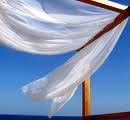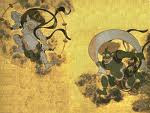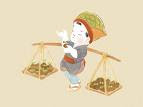[ . BACK to WORLDKIGO TOP . ]
::::::::::::::::::::::::::::::::::::::::::::::::::::::::::::::::::::::::::::::::::::::::::::::::::::
Christian Celebrations in Japanese Kigo
***** Location: Japan
***** Season: Various, see below.
***** Category: Observance
*****************************
Explanation
Today, about one to two million Japanese are Christians (about 1% of Japan's population). Most of them live in Western Japan where the missionaries' activities were greatest during the 16th century.
A few Christian customs have become quite popular also among the non-Christian population. Such customs are the wearing of white dresses at weddings or the celebration of St.Valentine's Day and, to a certain grade, also Christmas.
In the year 1542, the first Europeans from Portugal landed on Kyushu in Western Japan. The two historically most important things they imported to Japan were gunpowder and Christianity. The Japanese barons on Kyushu welcomed foreign trade especially because of the new weapons, and, therefore, tolerated the Jesuit missionaries. The missionaires were successful in converting quite large numbers of people in Western Japan including members of the ruling class. In 1550,
Francis Xavier also undertook a mission to the capital Kyoto.
source : www.japan-guide.com
:::::::::::::::::::::::::::::::::::::::::::::::::::::::::::::::::::::::::::::::::::::::::::::::::::
Persecution under the Shogunate
Under Hideyoshi and then under the succeeding Tokugawa shogunate, Catholic Christianity was repressed and adherents were persecuted. During these times, many Christians were killed in Japan, some by crucifixion; most famously, the twenty-six martyrs of Japan were tortured and crucified on crosses outside Nagasaki to discourage Christianity in 1597. Following a brief respite that occurred as Tokugawa Ieyasu rose to power and pursued trade with the Iberian powers, there were further persecutions and martyrdoms in 1613, 1630, and 1632.
By this point, after the
Shimabara Rebellion, the remaining Christians had been forced to publicly renounce their faith. Many continued practicing Christianity in secret, in modern times becoming known as the "hidden Christians" (隠れキリシタン, kakure kirishitan). These secret believers would often conceal Christian iconography within closed shrines, lanterns or inconspicuous parts of buildings.
For example, Himeji Castle has a Christian cross on one of its 17th-century roof tiles, in place of a mon, indicating that one of its occupants was a secret Christian. Drawn from the oral histories of Japanese Catholic communities, Shusaku Endo's acclaimed historical novel "Silence" provides detailed fictionalised accounts of the persecution of Christian communities and the suppression of the Church.
(Endo Shusaku 遠藤周作)
© More in the WIKIPEDIA !
:::::::::::::::::::::::::::::::::::::::::::::::::::::::::::::::::::::::::::::::::::::::::::::::::::
Pictures of Christian figures used during the Edo period (1600-1868) to identify adherents of Christianity, proscribed in 1613. Suspects were ordered to trample these Christian images underfoot on the assumption that those who refused or hesitated revealed themselves as Christians.
Official use of fumie as an instument of control continued until 1858.
. Stepping on a Christian image
(fumi-e, fumie, ebumi 踏絵 絵踏)
kigo for early spring
Some Christian celebrations are also KIGO in Japan.
Let us look at them through the seasons.
These celebrations are all bound to a calendar reference defining their season.
Read the general points to consider HERE:
. Calendar references and KIGO
:::::::::::::::::::::::::::::::::::::::::::::::::::::::::::::::::::::::::::::::::::::::::::::::::::
SPRING
kigo for early spring
nijuuroku seijinsai 二十六聖人祭 (にじゅうろくせいじんさい)
celebration of the 26 saints
..... chimeisai 致命祭(ちめいさい)
On the 5th of February, in 1597, Toyotomi Hideyoshi ordered the execution of 26 christian people in Nagasaki, 3 of them where Japanese Jesuits. Later Pope Pius 9 canonized them in 1861.
.................................................................................
. Barentain Dii バレンタインデー Valentine Day
barentain no hi バレンタインの日 (ばれんたいんのひ)
. shanikusai 謝肉祭 (しゃにくさい) carneval, carnival
Karneval, Fasching
including
. hai no suiyoobi 灰の水曜日Ash Wednesday. Aschermittwoch .
and Fat Tuesday (Mardi Gras)
:::::::::::::::::::::::::::::::::::::::::::::::::::::::::::::::::::::::::::::::::::::::::::::::::::
kigo for mid-spring
sei Yosefu sai 聖ヨセフ祭 (せいよせふさい) feast of Saint Joseph
..... shugoshasai 守護者祭(しゅごしゃさい)
..... joohaisai 浄配祭(じょうはいさい)
Fest des Heiligen Josef
.................................................................................
o-tsugesai 御告祭 おつげさい Annunciation
kami no o-tsuge 神のお告げ(かみのおつげ), gokuchisai 告知祭(こくちさい)、o-tsuge no shukujitsu お告げの祝日(おつげのしゅくじつ), jutai kokuchibi 受胎告知日(じゅたいこくちび)、seitai gokuchibi 聖胎告知日(せいたいこくちび)
Maria Verkündigung
The Angelus Domini is the traditional form used by the faithful to commemorate the holy annunciation of the angel Gabriel to Mary.
. . Angelus prayer
.................................................................................
shishunsetsu 四旬節 (しじゅんせつ) lent
..... taisaisetsu 大斎節(たいさいせつ)
rento レント、Lent
shijunsai 四旬祭(しじゅんさい), shijunsai 四旬斎(しじゅんさい)
The season of Lent is a 40-day period of fasting and prayer, which leads up to the great feast of Christ's resurrection, Easter, in the Christian calendar. Lent starts on Ash Wednesday and ends with Easter Eve, the day after Good Friday, when we remember Jesus resting dead in his tomb and prepare ourselves to celebrate his resurrection.
. Lent in Europe
including
junan no jujitsu 受難の主日 (じゅなんのしゅじつ)
Palmsunday, Palmsonntag
sei kinyoobi 聖金曜日 せいきんようび Good Friday, Karfreitag
seidoyoobi 聖土曜日 (せいどようび) Holy Saturday, Karsamstag
:::::::::::::::::::::::::::::::::::::::::::::::::::::::::::::::::::::::::::::::::::::::::::::::::::
kigo for late spring
. fukkatsu-sai 復活祭り、iisutaa イースター
Easter / Ostern
iisutaa eggu イースターエッグ Easter egg
pasuka パスカ、pasuha パスハ、paaku パーク Pashka
Russian Easter cheese dessert
and
shiroki nichiyoobi 白き日曜日 (しろきにちようび)White Sunday
:::::::::::::::::::::::::::::::::::::::::::::::::::::::::::::::::::::::::::::::::::::::::::::::::::
SUMMER
kigo for early summer
seibozuki 聖母月 (せいぼづき) month of the holy mother
..... Maria no tsuki マリアの月(まりあのつき)month of Maria
The month of May.
shootensai 昇天祭 (しょうてんさい) Ascension of Christ
..... shooten no hi 昇天日(しょうてんび)
goshooten 御昇天(ごしょうてん)
Himmelfahrt
:::::::::::::::::::::::::::::::::::::::::::::::::::::::::::::::::::::::::::::::::::::::::::::::::::
kigo for mid-summer
hana no hi 花の日 (はなのひ) "day of flowers"
..... hana no nichiyo 花の日曜(はなのにちよう)sunday of flowers
bara no nichiyo 薔薇の日曜(ばらのにちよう)sunday of roses
Most often the second sunday in July.
Rosensonntag, Freudensonntag, Lätare
The fourth Sunday in Lent is Laetare, also called Refreshment Sunday.
Mothering Sunday, Laetare in Europe
.................................................................................
sei Yohanne sai 聖ヨハネ祭 (せいよはねさい)
Feast of Saint John
..... senja sei Yohanne sai 仲夏 洗者聖ヨハネ祭(せんじゃせいよはねさい)
Feast of Saint John the Baptist
..... senja sei Yohanne tanjoobi 洗者聖ヨハネ誕生日(せんじゃせいよはねたんじょうび)
birthdy of Saint John, the Baptist
der Heilige Johannes der Täufer
. Golowan Festival, Cornwall .
England
Midsummer’s Day is the church feast of St John The Baptist,
.................................................................................
sei Petoro . Pauro sai 聖ペトロ・パウロ祭
(せいぺとろ・ぱうろさい)
Feast of Saints Peter and Paul
July 29
Hochfest Peter und Paul
.................................................................................
seirei koorin sai 聖霊降臨祭 (せいれいこうりんさい)
Pentecost
pentekosute ペンテコステ
seireisai 聖霊祭(せいれいさい)/降臨祭(こうりんさい)
gojunsetsu 五旬節(ごじゅんせつ)
Pfingsten
sanmisai 三位祭 (さんみさい) Trinity Sunday
seisanmisai 聖三位祭(せいさんみさい)
shiseisai 至聖祭(しせいさい)
Celebrated on the next sunday after pentecoste.
Dreifaltigkeitsfest; Trinitatisfest
seitaisai, seitai sai 聖体祭 (せいたいさい)
Corpus Christi Festival
Fronleichnam "Hochfest des Leibes und Blutes Christi"
. Corpus Christi Procession
:::::::::::::::::::::::::::::::::::::::::::::::::::::::::::::::::::::::::::::::::::::::::::::::::::
kigo for late summer
Nippon fukushasai 日本福者祭 (にっぽんふくじゃさい)
canonization day of Japan
July 7. Sometimes also celebrated on September 10.
On this day, the pope Pius 9 canonized about 250 Japanese people.
:::::::::::::::::::::::::::::::::::::::::::::::::::::::::::::::::::::::::::::::::::::::::::::::::::
AUTUMN
kigo for early autumn
hishootensai 被昇天祭 (ひしょうてんさい)
Feast of the Assumption
hishooten no shukujitsu 被昇天の祝日(ひしょうてんのしゅくじつ)
seibo hishootensai 聖母被昇天祭(せいぼひしょうてんさい)Assumption of Mary
seibosai 聖母祭(せいぼさい)
August 15. Mariä Himmelfahrt
fukuremanjuu no iwaibi ふくれ饅頭の祝日(ふくれまんじゅうのいわいび)
day for celebrating whith puffed manju ricecakes
. . . CLICK here for Photos of the manju from Nagasaki!
seibo seishinsai 聖母聖心祭 (せいぼせいしんさい)
The Immaculate Heart of Mary
August 22
:::::::::::::::::::::::::::::::::::::::::::::::::::::::::::::::::::::::::::::::::::::::::::::::::::
 source : www.pinterest.com
Hand painted Virgin Mary as Daruma Doll
kigo for mid-autumn
seibo seitansai 聖母生誕祭 (せいぼせいたんさい)
source : www.pinterest.com
Hand painted Virgin Mary as Daruma Doll
kigo for mid-autumn
seibo seitansai 聖母生誕祭 (せいぼせいたんさい)
Nativity of the Blessed Virgin Mary
..... gyooseisai 暁星祭(ぎょうせいさい)
September 8
Naşterea Sf. Fecioare Maria / Nativity of the Virgin Mary;
aka “Sântămăria Mică” / ”Little St. Mary’s” in Romania
juujikasai, juujika sai 十字架祭 (じゅうじかさい)
Exaltation of the Cross
juujika no shoosan no shukujitsu 十字架の称讃の祝日
(じゅうじかのしょうさんのしゅくじつ)
Triumph of the Holy Cross.
September 14
. sei Mikaeru sai 聖ミカエル祭 (せいみかえるさい)
Feast of Saint Michael
September 29
tenshisai, tenshi sai 天使祭 (てんしさい)
"festival of angels" . Angel Festival
shugo no tenshi no iwaibi
守護の天使の祝日(しゅごのてんしのいわいび)
celebration day for the protector angles
October 2
 - Reference -
- Reference -
:::::::::::::::::::::::::::::::::::::::::::::::::::::::::::::::::::::::::::::::::::::::::::::::::::
kigo for late autumn
. rozario no seibo no hi ロザリオの聖母の日(ろざりおのせいぼのひ)
Our Lady of the Rosary
rozario sai, rosariosai ロザリオ祭 (ろざりおさい)"Feast of the Rosary"
October 7
. Banseietsu 万聖節 (ばんせいせつ) All Saints' Day
Allerheiligen
November 1
. Shareisai 諸霊祭 (しょれいさい) All Souls Day
Allerseelen
November 1
:::::::::::::::::::::::::::::::::::::::::::::::::::::::::::::::::::::::::::::::::::::::::::::::::::
WINTER
kigo for early winter
. kanshasai 感謝祭 (かんしゃさい) Thanksgiving
..... shuukaku kanshasai 収穫感謝祭(しゅうかくかんしゃさい)
harvest thanksgiving
sometimes placed in mid-autumn
.................................................................................
Day of Saint Xavier
Sei Sabieru no hi 聖ザビエルの日 (せいざびえるのひ)
December 3
Sei Furanshisuko Sabieru shi sai no iwaibi
聖フランシスコ=ザビエル司祭の祝日
(せいふらんしすこざびえるしさいのいわいび)
Sabieru no iwaibi ザビエルの祝日(ざびえるのいわいび)
Sei Sabieru sai 聖ザビエル祭(せいざびえるさい)
Feast for Saint Xavier
Saint Francis Xavier, born Francisco de Jaso y Azpilicueta (7 April 1506, Javier, Navarre – 3 December 1552, Shangchuan Island, China) was a pioneering Roman Catholic missionary born in the Kingdom of Navarre (Spain) and co-founder of the Society of Jesus.
He was influential in the spreading and upkeep of Catholicism most notably in India, but also ventured into Japan, Borneo, the Moluccas, and other areas which had thus far not been visited by Christian missionaries.
© More in the WIKIPEDIA !
. WKD : Xavier, Saint Francis Xavier,
sei Sabieru 聖ザビエル (1506 - 1552)
.................................................................................
. advent, taikoosetsu 待降節 (たいこうせつ)
:::::::::::::::::::::::::::::::::::::::::::::::::::::::::::::::::::::::::::::::::::::::::::::::::::


"Madonna of the Snow"
painted by Sister Teresa, a Carmelite nun of the Holy Trinity convent ~ Chofu-shi, Tokyo.
:::::::::::::::::::::::::::::::::::::::::::::::::::::::::::::::::::::::::::::::::::::::::::::::::::
kigo for mid-winter
seitaisetsu 聖胎節 せいたいせつ
day of the Immaculate Conception (of Virgin Mary)
Feast of the Immaculate Conception
December 8
..... dootei Sei Maria nugenzai no onyadori no iwaibi
童貞聖マリア無原罪の御孕りの祝日
(どうていせいまりあむげんざいのおんやどりのいわいび)
mugenzai no Sei Maria no saijitsu
無原罪の聖マリアの祭日 (むげんざいのせいまりあのさいじつ)
Maria no onyadori no hi
マリア様の御孕りの日(まりあさまのおんやどりのひ)
.................................................................................
 . Christmas
. Christmas
kurisumasu クリスマス Christmas, Weihnachten
December 25, 26
kirisuto kootansai キリスト降誕祭(きりすとこうたんさい)
birth of Christ
..... kootansai 降誕祭(こうたんさい)
..... seitansai 聖誕祭(せいたんさい)"holy birthday"
..... gokootansetsu 御降誕節(ごこうたんせつ)
seiju 聖樹(せいじゅ)"holy tree", Tannenbaum
kurisumasu oo-uridashi
クリスマス大売出し(くりすますおおうりだし)
Christmas sale
kurisumasu ibu クリスマスイブ
Christmas eve
evening of December 24
seiya 聖夜(せいや)Holy Night
seiyageki 聖夜劇(せいやげき)"Holy Night performance"
Krippenspiel
kurisumasu kaado クリスマスカード Christmas card
kurisumasu kyaroru クリスマスキャロル Christmas carol
Weihnachtslied
seika 聖菓(せいか)"Holy Cake", Christmas cake
Day of the Holy Family
seikazoku no hi 聖家族の日 (せいかぞくのひ)
seikazoku no jujitsu 聖家族の主日(せいかぞくのしゅじつ)
nazareto no seikazoku no iwaibi
ナザレトの聖家族の祝日(なざれとのせいかぞくのいわいび)
Festival Day of the Holy Family from Nazareth
.................................................................................
Day of Saint John
Sei Johanne no hi 聖ヨハネの日 (せいよはねのひ)
..... Sei Johanne no iwaibi
聖ヨハネの祝い日(せいよはねのいわいび)
December 27
John the Apostle
© More in the WIKIPEDIA !
:::::::::::::::::::::::::::::::::::::::::::::::::::::::::::::::::::::::::::::::::::::::::::::::::::
kigo for late winter
. Candlemass. seishokusai 聖燭祭 (せいしょくさい)
..... shu no hooken 主の奉献(しゅのほうけん)
Presentation of Jesus at the Temple
主の迎接祭(しゅのげいせつさい)
February 2
.................................................................................
. Epiphany, koogen no hi
公現の日 こうげんのひ
Three Kings Day, January 6
gokoogen 御公現(ごこうげん)
ju no gokoogen no iwaibi
主の御公現の祝日(しゅのごこうげんのいわいび)
:::::::::::::::::::::::::::::::::::::::::::::::::::::::::::::::::::::::::::::::::::::::::::::::::::
observance kigo for the New Year
hatsu misa 初弥撒 (はつミサ) first missa, first mass
..... misa hajime 弥撒始(ミサはじめ)
kami no haha seibo maria no iwai 神の母聖マリアの祝日
(かみのははせいマリアのいわいび)
celebrating Maria, mother of God
Erste Messe
SAIJIKI – NEW YEAR OBSERVANCES
:::::::::::::::::::::::::::::::::::::::::::::::::::::::::::::::::::::::::::::::::::::::::::::::::::
topics for haiku
baiburu バイブル bible, die Bibel
seisho 聖書 the holy scirptures, die Heilige Schrift
バイブルをよむ寂しさよ花の雨
baiburu o yomu sabishisa yo hana no ame
this loneliness
when reading the bible -
rain on cherry blossoms
. Sugita Hisajo 杉田久女 (1890 - 1946) .
with more translations of this poem
胸の上聖書は重し鳥雲に
mune no ue seisho wa omoshi tori kumo ni
on my chest
the bible is heavy . . .
birds into clouds
Nomiyama Asuka 野見山朱鳥
(1920-1970)
. tori kumo ni iru 鳥雲に入る .
birds disappear in the clouds
カステラと聖書の厚み春深し
kasutera to seisho no atsumi haru fukashi
Castella cake
and the thickness of the bible -
spring deepens
Iwabuchi Kiyoko 岩淵喜代子
Castella found its way to Japan from Nagasaki, just as Christianity.
. kasutera カステラ Kastella, Castella - chiffon cake, sponge cake .
.................................................................................
crescent moon --
a pressed rose falls
from the family bible
- Shared by Deborah Barbour Lundy -
Joys of Japan, 2012
August chill
the crisp pages
of an old bible
- Shared by Ella Wagemakers -
Joys of Japan, 2012
church blast --
blood droplets
on the bible
L Otakwa
Kenya, October 2012
..........................................................................
sanbika 賛美歌 bible hymn, hymns - Hymne
賛美歌や足長くらげ掌にとろけ
sambika ya ashinaga kurage te ni toroke
this hymn -
a jelly fish with long legs
melts in my palm
. Mitsuhashi Takajo 三橋鷹女 .
:::::::::::::::::::::::::::::::::::::::::::::::::::::::::::::::::::::::::::::::::::::::::::::::::::::
 guregorio seika グレゴリオ聖歌 Gregorian Church Songs
guregorio seika グレゴリオ聖歌 Gregorian Church Songs
cantus gregorianus, Gregorian chant, Gregorianischer Choral
グレゴリオ聖歌の坂の花林檎
guregorio seika no saka no hana-ringo
Gregorian hymns
at the slope
with apple blossoms
Ishihara Yatsuka 石原八束
(1919-1998)
:::::::::::::::::::::::::::::::::::::::::::::::::::::::::::::::::::::::::::::::::::::::::::::::::::::
February 7, 2012
shared by Johnny Baranski, Joys of Japan, February 2012
St. Paul Miki,
today is the feast of St. Paul Miki, a Jesuit brother born in Tounucamada, Japan in the 1500s who was martyred for preaching the Gospel with 25 other Catholics; they were crucified on a hill overlooking the city of Nagasaki. They were canonized in 1862, about the same time Christianity returned to Japan. Though a minority religion in Japan the largest concentration of Catholics is in and around Nagasaki. The Catholic Cathedral in that city was the epicenter of the atomic bomb dropped there toward the end of WWII.
quote
MARY MIRACULOUS
Johnny Baranski
described as half bleached white and charcoal black she's called "Atomic Bombed Maria." her remains were found amid the ruins of Urakami Catholic Cathedral in Nagasaki, Japan after the city was flattened by the nuclear weapon dubbed "fat man" on August 9th, 1945; that is, only the statue's head, it being all that was still intact. weep not for her, however, for her hollow wooden visage is no specter of death. instead its muted voice joins those around the world calling for disarmament. believers say whatever is asked for through her shall be granted.
disfigured by the BOMB
the Virgin's likeness too
a Hibakusha*
* The surviving victims of the atomic bombings of Hiroshima and Nagasaki are called hibakusha -a Japanese word that literally translates to "explosion-affected people.”
source : www.ahapoetry.com/ahalynx
 source : isshin3_ph
source : isshin3_ph
被爆マリア聖堂 hibaku Maria
.................................................................................
ふるさとのマリアの涙原爆忌
furusato no Maria no namida genbaku ki
in my homeland
the tears of Maria -
Atom Bomb Memorial Day
Yamaguchi Momori 山口桃里
source :twitter junfuugetsu
. Selected by Kaneko Tohta at Asahi Haidan .
金子兜太 選, Heisei 22 (2010)
*****************************
Worldwide use
26 December -- St Stephen, the earliest martyr of the church.
St Stephen's Day
more about
. The twelve days of Christmas
. . . . .
For more Christian Celebrations and Festivals (feasts)
please check here
. . . . WKD : ABC-INDEX
*****************************
Things found on the way
Gründonnerstag in Deutschland
(auch Hoher, Heiliger oder Weißer Donnerstag bzw. Palmdonnerstag)
© More in the WIKIPEDIA !
Maundy Thursday in England
© More in the WIKIPEDIA !
:::::::::::::::::::::::::::::::::::::::::::::::::::::::::::::::::::::::::::::::::::::::::::::::::::::::
Ideology and Christianity in Japan
By Kiri Paramore
ISBN: 978-0-415-60371-3
Ideology and Christianity in Japan shows the major role played by Christian-related discourse in the formation of early-modern and modern Japanese political ideology.
The book traces a history development of anti-Christian ideas in Japan from the banning of Christianity by the Tokugawa shogunate in the early 1600s, to the use of Christian and anti-Christian ideology in the construction of modern Japanese state institutions at the end of the 1800s. Kiri Paramore recasts the history of Christian-related discourse in Japan in a new paradigm showing its influence on modern thought and politics and demonstrates the direct links between the development of ideology in the modern Japanese state, and the construction of political thought in the early Tokugawa shogunate.
Demonstrating hitherto ignored links in Japanese history between modern and early-modern, and between religious and political elements this book will appeal to students and scholars of Japanese history, religion and politics.
source : www.routledge.com
:::::::::::::::::::::::::::::::::::::::::::::::::::::::::::::::::::::::::::::::::::::::::::::::::::::
THE HEBREW LUNAR CALENDAR
Nisan was determined by a celestial event. The
Nisan moon was the first moon that would become a full moon after the passing of the spring equinox. Nisan thereby marked the first month of the year on the Hebrew calendar for the religious year. The Nisan moon, confirmed by the ripening of the barley harvest determined the month in which Passover would be celebrated.
source : endtimepilgrim.org
Nisan moon
at Gethsemane ~
third sunrise
- Shared by Elaine Andre
Joys of Japan, 2012
*****************************
HAIKU
 回転木馬は降誕祭の星となる
回転木馬は降誕祭の星となる
kaiten mokuba wa kootansai no hoshi to naru
this merry-go-round
on Christmas Day
becomes a star
Senda Yoko (Senda Yooko) 仙田洋子 (1962 - )
::::::::::::::::::::::::::::::::::::::::::::::::::::::::::::::::::::::::::::::::::::::::::::::::::::
釘うてる天主の手足露の花園
kugi uteru tenshu (deusu デウス ) no teashi tsuyu no kaho
The Lord's hands and feet,
with the nails hammered through them---
dewdrops on blossoms.
Composed 1927.
On a business trip to Nagasaki, in Kyushu, I visited the
Ooura Catholic Church and the image of Jesus on the cross in the flower garden. Nails in his hands and feet. Dewdrops on the flowers in the garden. I thought of the blood flowing on his hands and feet.
. Yamaguchi Seishi 山口誓子 .
Comment by the translators Kodaira and Marks
Nagasaki was one of the principal areas of missionary activity when Christianity was introduced to Japan in the sixteenth century. Ooura Catholic Church was built in 1864 and dedicated to 26 Christians crucified in 1597. Today the church has been designated a national treasure.

長崎 大浦天主堂
Oura Cathedral Nagasaki
More haiku written by Seishi in Nagasaki
露の花圃天主(デウス)を祈るもの来たる
露の花圃神父童に語ります
主の前の日焼童に聖寵(ガラス)あれ
旅びとや夏ゆふぐれの主に見(まみ)ゆ
source : haiku weekly
*****************************
Related words
*****
. Saints and their Memorial Days
*****
. Shrovetide (Maslenitsa) - Russia .
*****
. Noah's ark - Die Arche Noah - ノアの箱舟.
*****
. Holy Innocents .
December 28
*****
. Karematsu Jinja 枯松神社 and hidden Christians .
Nagasaki
*****
. Jewish Holidays and Celebrations .
*****
. SAIJIKI
OBSERVANCES, FESTIVALS, RITUALS
:::::::::::::::::::::::::::::::::::::::::::::::::::::::::::::::::::::::::::::::::::::::::::::::::::::
[ . BACK to DARUMA MUSEUM TOP . ]
[ . BACK to WORLDKIGO . TOP . ]
:::::::::::::::::::::::::::::::::::::::::::::::::::::::::::::::::::::::::::::::::::::::::::::::::::::







































